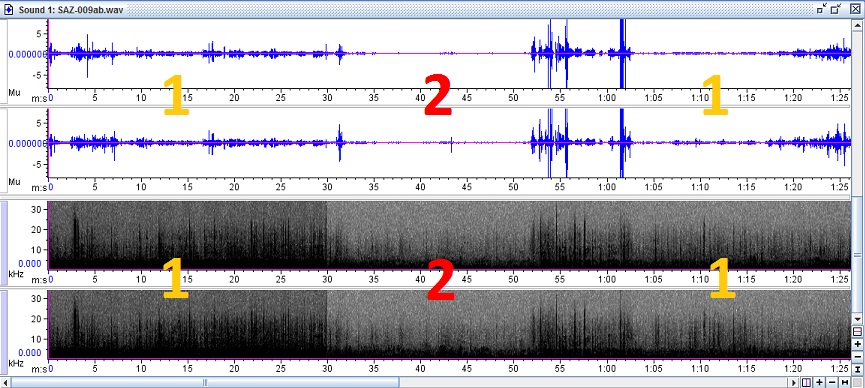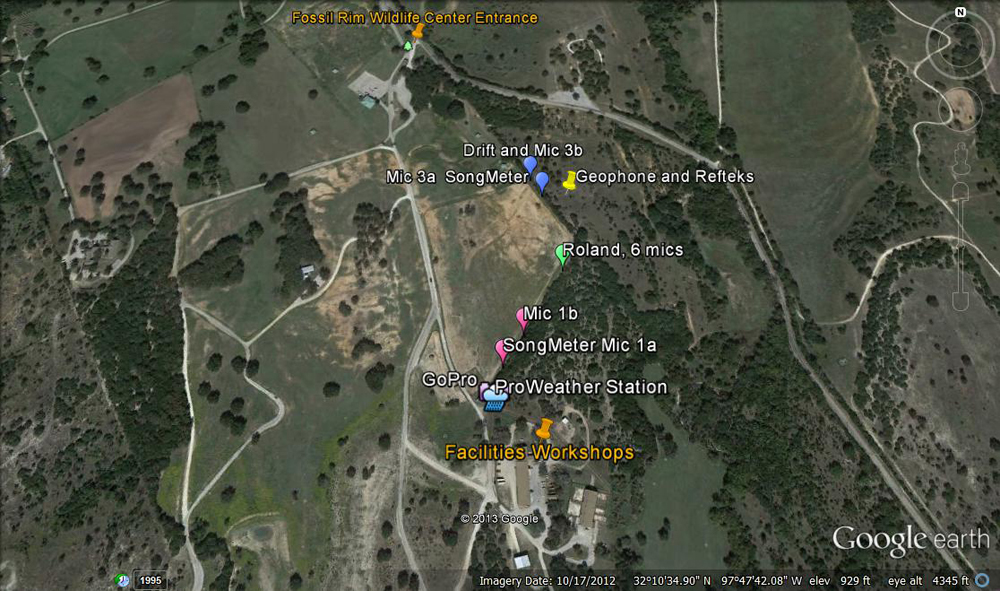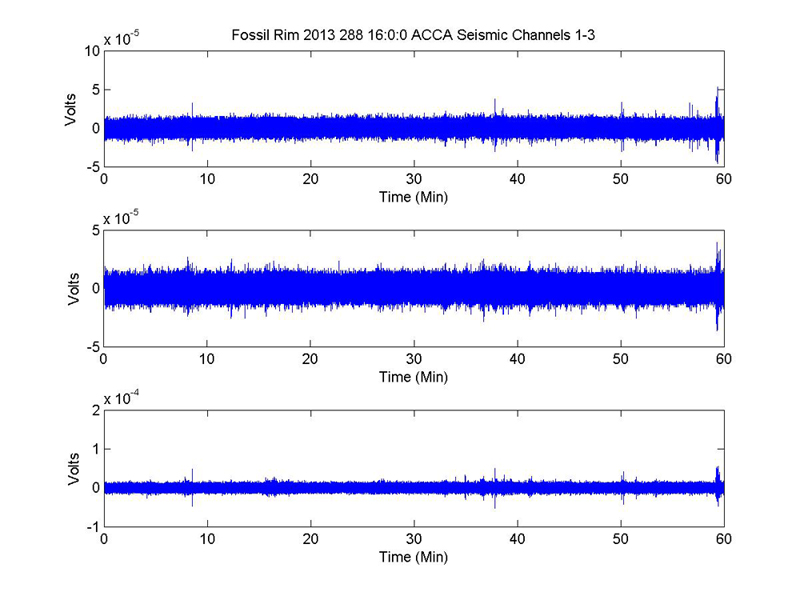
Suzi Wiseman, Doctoral Candidate – sw1210txstate@gmail.com
Texas State University-San Marcos
Environmental Geography
601 University Drive, San Marcos, Texas 78666
Frank Sepulveda, Doctoral Student – Frank_Sepulveda@baylor.edu
Baylor University
Geophysics
One Bear Place #97354, Waco, Texas 76798
Dr. Preston S. Wilson, Associate Professor – wilsonps@austin.utexas.edu
Univ. Texas at Austin
Mechanical Engineering Department
1 University Station C2200
Austin, TX 78712
Popular version of paper 4aAB6
Presented Thursday morning, December 5, 2013
166th ASA Meeting, San Francisco
Many creatures, including the myopic Southern White Rhinoceros, depend on hearing and smell more than on sight. Thus their Soundscape (what they hear around them) is likely to be more crucial than their Landscape (what they see).
Schafer (1977) formalized the concept of soundscape to describe the ''auditory properties of landscapes'' and chose key acoustic terms to parallel visual elements. For an animal that relies on its soundscape, does chronic or extreme noise or distorted sound mask vital cues like a fog might mask visual cues?
Nature is dominated by biophonic (biologically produced) and geophonic (geophysically produced) sounds that are quickly absorbed by soil and vegetation (Krause 1987). Natural soundscapes are information-rich and directly and indirectly essential to survival (Wilson 1984). Urban soundscapes are anthrophonic, with vastly different physical and semantic characteristics. Sound reflects off hard geometric surfaces and distorts and reverberates. Much of it is infrasonic or ultrasonic, too low or too high for humans to perceive but well within the optimum hearing range of other species. Urban zoos tend to be enveloped in this anthrophonic soundscape. Fig. 1 describes the interaction of natural and anthrophonic soundscapes and reveals ecological implications. Studies show substantial changes in foraging and anti-predator behavior, reproductive success, habitat selection, vulnerability, longevity, abundance and community structure in a number of species exposed to noise, and certain laboratory animals exposed to chronic noise exhibit many physiologically similar responses as humans.

Fig. #1: Pijanowski's conceptual framework describes the ecological characteristics of the soundscape. (Pijanowski et al. 2011)
Rhinos often breed poorly in urban zoos. Herd size and composition, the age and experience of potential mates, substrate, enclosure design and other factors have been studied but little attention if any has been paid to their soundscape. Since noise impacts human health and reproduction, might it impact larger mammals with exquisite hearing as much, or perhaps even more?
Rhinos have been recorded vocalizing infrasonically and sonically from 5 Hertz (Hz) or even lower (Baskin 1992) up to almost 8 kHz (Policht 2008), indicating sensitivity in this range. Since infrasonic noise is chronic in cities, many animals would be exposed. Fig. 2 reveals the sound shadow found by one urban zoo rhino whose enclosure is sunken below ground, under a cliff at the top of which is a major road intersection. The ambient noise was recorded first from above the rhino's wall (position 1) and then the sound shadow from leaning down the wall briefly towards the rhino's favorite spot, which was even further down under a ledge (position 2).

Fig. #2: He had found a sound shadow, as indicated in the center of this sound clip by the waveform (acoustic pressure over time) and spectrogram (frequency over time) recorded from position 1, compared with position 2 lower down his wall. A considerable amount of low frequency noise is also evident.
The World Health Organization (1999) highlights how chronic and/or extreme noise damage humans physiologically. Certain acoustic parameters are particularly injurious. Some relate to reproductive complications, from issues of fertility to fetal loss and infant death syndrome. The acoustic parameters most injurious to humans are chronic noise, high amplitude, low frequency (high frequency too, but to a lesser degree), impulse noise, vibration, fluctuating noise, noise during sleeping periods, unrecognized sounds, uncontrollable sounds, and sounds that are likely to cause fear.
Animal responses usually depend on sound level, rate of onset, duration, number of events, spectral distribution of sound energy, presence of pure tones, and the relative level of background noise (Pater, Grubb and Delaney 2009). The meaning of the sound is also important. But do they respond physiologically like humans to the parameters above?
While biological research has been conducted on certain zoo animals exposed to specific noise, no studies comprehensively assess zoo soundscapes, and particularly not from a geographic viewpoint. The only study relating to zoo rhinos' sensitivity to noise was a small portion of a study on housing facilities by Carlstead et al. (1999). Possibly due to the limitations of their sample size and sampling methods, it did not produce statistically significant correlations but did indicate general trends relating to noise and to the acoustical effects of the captive environment itself. The author reminds readers that correlations are not sufficient evidence to assume cause or effect, but they may suggest the advisability of further research.
How can we examine the soundscape that animals might perceive? Are acoustic parameters that are particularly injurious to humans, present within the animals' auditory range? Do certain endangered species that breed poorly in captivity, or are declining near ever-increasing urban influence, exhibit similar physiological and behavioral symptoms to humans exposed to chronic noise, that reduces their well-being and abundance?
This project addresses the first two questions by developing a methodology to comprehensively document and measure the infrasonic, sonic and seismic soundscape around an animal enclosure - namely the white rhino enclosure at Fossil Rim Wildlife Center in Texas, one of six Conservation Centers for Species Survival and one of the few facilities to successfully breed this species in recent years. Three sonic acoustic systems with eight omni-directional and two directional microphones recorded along one side of the rhino enclosure continuously for a week, plus six infrasonic sensors and a geophone recording ground vibration (see Fig. 4). Cameras were mounted at each end of the enclosure while a ProWeather station monitored changing atmospheric conditions. Raven Professional Software is used for the sonic analysis, and Matlab for the infrasonic.

Fig. #3: Layout of the recording systems at Fossil Rim Wildlife Center's white rhino enclosure
Due to lack of automation for this process, it will take months to data mine the 1.5 TB of sonic data alone to characterize all the common and extreme sound events and the ambient background of this first soundscape, searching for sound parameters injurious to humans, the parameters that animals have been shown to respond to the most, and the interaction and patterns of various sound events.
However, keynotes (which are like the background in a landscape) have been identified, plus unique soundmarks (which compare to landmarks) and sound signals (which compare to foreground). The most common keynotes include the activities of utilities and ground staff, road traffic outside the wildlife center, aircraft movements, and weather events. The sources of the highest amplitudes are usually machinery used in maintenance. The most significant soundmarks each day include visitors' voices and their slowly moving vehicles on the trails past the rhino enclosure, and the zoo's open minibus tours, with the voices of nocturnal park and wild animals in the surrounding district at night. Distinctive soundmarks were several gunshots on a neighboring ranch one evening. Sound signals mainly comprised the vocalizations and movements of conspecifics and other ungulates that ventured into and around the rhino enclosure, birds and insects, and particularly the recognized voices, vehicles and activities of the keepers and animal care staff that interacted with the rhinos and nearby animals.
In addition to acoustic parameters, humans have been shown to respond poorly to vibration. Certain species including elephants and rhinos appear to communicate by stomping their hooves and "listening" to sensations they feel in the ground. This indicates they are likely to be particularly sensitive to ground vibration.
As part of a collaborative effort between Baylor University (Geology Department) and Texas State University-San Marcos (Geography Department), geophysical infrasonic and seismic data acquisition systems and sensors were used to characterize the infrasonic soundscape and the ambient seismic background noise. Geophysical systems were chosen for this rather than conventional acoustic systems since geophysical data acquisition and sensors are inherently rugged, draw low power, are GPS time accurate, and span the entire infrasonic frequency range (0.1 Hz to 20 Hz). Fig. 5 shows an example of the seismic data preliminarily processed via Matlab.

Fig. #4: One hour of data showing considerable seismic activity at 3 different scales
The infrasonic and seismic data are being analyzed according to established signal processing techniques to characterize Fossil Rim's infrasonic soundscape and ambient seismic background noise (natural and anthropogenic). Statistical approaches developed for the characterization of ambient seismic background noise will be implemented to describe the infrasonic soundscape (non-transient events), with the intent of developing an infrasonic soundscape characterization method that minimizes the analyst's workload.
Subsequent infrasonic soundscape characterization efforts will include the development of an Infrasonic Automated Transient Characterization Algorithm (IATCA). The IATCA will automatically detect transient infrasonic Events of Interest (EoI), analyze EoI, and save EoI metrics (rise time, pulse width, signal to noise, etc) in tabular form for statistical analysis.
Once a reliable methodology has been developed to measure and characterize the sonic, infrasonic and seismic soundscape of a captive animal facility, a range of soundscapes in which an individual endangered species is healthy and is reproducing could be compared with soundscapes in which that species is not. Correlations could be sought, along with any associations with the animals' physiological and behavioral status. Problematic acoustic parameters could be ameliorated. Ultrasonic soundscapes could also be analyzed for appropriate species.
Understanding soundscapes and their implications may well prove significant not only for endangered species, but for all captive animals in conservation, agricultural and even domestic environments, and for wildlife whose habitats are being encroached upon by man.
References:
Baskin, Y. 1992. The rhino's silent call. In Discover Magazine [database online]. 1 April. http://discovermagazine.com/1992/apr/therhinossilentc38 (last accessed 11 November 2013).
Carlstead, K., J. Fraser, C. Bennett, and D. G. Kleiman. 1999. Black rhinoceros (Diceros bicornis) in US zoos: II. Behavior, breeding success, and mortality in relation to housing facilities. Zoo biology 18:35-52.
Krause, B. 1987. The niche hypothesis. Whole Earth Review . Wild Sanctuary. Pater, L. L., T. G. Grubb, and D. K. Delaney. 2009. Recommendations for improved assessment of noise impacts on wildlife. The Journal of Wildlife Management 73:788-795.
Pijanowski, B. C., A. Farina, S. H. Gage, S. L. Dumyahn, and B. L. Krause. 2011. What is soundscape ecology? An introduction and overview of an emerging new science. Landscape Ecology 1-20.
Policht, R., K. Tomasova, D. Holeckove, and D. Frynta. 2010. The vocal repertoire in Northern white rhinoceros Ceratotherium simum cottoni as recorded in the last surviving herd. Bioacoustics 18:69.
Schafer, R. M. 1977. The tuning of the world. Knopf.
Wilson, E. O. 1984. Biophilia. Harvard University Press.
World Health Organization. "Guidelines for community noise". WHO Expert Taskforce Meeting. London. 1999.